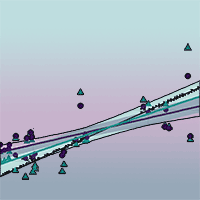
The recreational valuation of a natural forest park using travel cost method in Iran
B Sohrabi Saraj (1), A Yachkaschi (1), D Oladi (1), S Fard Teimouri (1), H Latifi (2)
iForest - Biogeosciences and Forestry, Volume 2, Issue 3, Pages 85-92 (2009)
doi: https://doi.org/10.3832/ifor0497-002
Published: Jun 10, 2009 - Copyright © 2009 SISEF
Research Articles
Abstract
One of the most important benefits of a forest, which can be considered over the revenue yielded from timber and other wood based products, is the recreational benefits for visitors. Considering the novelty and necessity of evaluating bio-environmental economics of forest parks in developing countries such as Iran, the present study will focus on the evaluation of the Willingness to Pay (WTP) for a northern Iranian Forest park (Abbas Abad-Behshahr as a case study) utilizing one of the worldwide common methods of evaluation (Travel Cost Method). Based on the method, the park was considered as the centre of the fivefold region as concentric circles. The number of visitors was determined using questionnaires and the park’s value was determined by estimation of the visitors access cost using Travel Cost Method. Furthermore, the economic value extracted timber products of the neighbouring forestry plan was reckoned. The calculated factor was then compared to the economic value of the park. As a result, the park’s recreational value was judged to be much more than produced timber values. Therefore, it is concluded that the unparalleled natural, historical and bio-environmental values of the park would be preserved by planning an appropriate and well- programmed management system, considering the unique conditions of the Park. Thus, it can fulfil the recreational requirements of the people in the local/national scale.
Keywords
Recreational evaluation, Abbas Abad Forest Park, Travel Cost Method (TCM), Willingness to Pay (WTP)
Authors’ Info
Authors’ address
A Yachkaschi
D Oladi
S Fard Teimouri
Dept. of forestry, Faculty of Natural Resources, University of Mazandaran, 10 km Sari-Neka Rd, P.O. Box 737, Sari (Iran)
Faculty of Forest and Environmental Studies, University of Freiburg, Freiburg (Germany)
Corresponding author
Paper Info
Citation
Sohrabi Saraj B, Yachkaschi A, Oladi D, Fard Teimouri S, Latifi H (2009). The recreational valuation of a natural forest park using travel cost method in Iran. iForest 2: 85-92. - doi: 10.3832/ifor0497-002
Academic Editor
Marco Borghetti
Paper history
Received: Dec 22, 2008
Accepted: Apr 09, 2009
First online: Jun 10, 2009
Publication Date: Jun 10, 2009
Publication Time: 2.07 months
Copyright Information
© SISEF - The Italian Society of Silviculture and Forest Ecology 2009
Open Access
This article is distributed under the terms of the Creative Commons Attribution-Non Commercial 4.0 International (https://creativecommons.org/licenses/by-nc/4.0/), which permits unrestricted use, distribution, and reproduction in any medium, provided you give appropriate credit to the original author(s) and the source, provide a link to the Creative Commons license, and indicate if changes were made.
Web Metrics
Breakdown by View Type
Article Usage
Total Article Views: 63420
(from publication date up to now)
Breakdown by View Type
HTML Page Views: 52635
Abstract Page Views: 3894
PDF Downloads: 5780
Citation/Reference Downloads: 91
XML Downloads: 1020
Web Metrics
Days since publication: 6015
Overall contacts: 63420
Avg. contacts per week: 73.81
Citation Metrics
Article Citations
Article citations are based on data periodically collected from the Clarivate Web of Science web site
(last update: Mar 2025)
Total number of cites (since 2009): 13
Average cites per year: 0.76
Publication Metrics
by Dimensions ©
Articles citing this article
List of the papers citing this article based on CrossRef Cited-by.
References
Habit formation and variety seeking in a discrete choice model of recreation demand. Journal of Agricultural and Resource Economics 19 (1): 19-31.
Gscholar
The travel cost model for lake recreation: a comparison of two methods for incorporating site quality and substitution effects. American Agriculture Economics Association, pp. 291-297.
Gscholar
Methods of measuring the demand for and value of outdoor recreation. Resources for the future, Reprint Number 10, Brookings Institutions, Washington, DC, USA.
Gscholar
Economics of outdoor recreation. The Johns Hopkins Press, Baltimore, ML, USA.
Gscholar
The measurement of environmental and resource values: theory and methods. Resources for the future, Washington, DC, USA.
Gscholar
Recreational-economical evaluation of Si Sangan forest park. Pajouhesh and Sazandegi 55: 92-95.
Gscholar
The economics of natural environments: studies in valuation of commodity and amenity resources. The Johns Hopkins University Press for Resources for the Future, Baltimore, ML, USA.
Gscholar
Economic evaluation of Khazaneh forest park. University of Tehran Press, Tehran, Iran, pp. 105.
Gscholar
Estimating recreational benefits of Kakamega forest in Kenya using the travel cost method. In: Proceedings of the Symposium: “Prosperity and Poverty in a Globalised World-Challenges for Agricultural Research”. Tropentag, Bonn, Germany.
Gscholar
An introduction to ecotourism (translation). University of Mazandaran Press, Mazandaran, Iran, pp. 384.
Gscholar
The value of ranch open space to tourists. Growth and change 30 (3): 66-73.
Gscholar
Ecotourism: principles, practices, and policies for sustainability, United Nations Environmental Program, Tour Mirabeau, France and the International ecotourism society, Burlington, VA, USA.
Gscholar
An introduction to the Iranian national and forest parks. University of Tehran Press, Tehran, Iran, pp. 135.
Gscholar

















